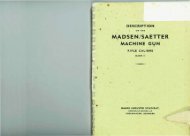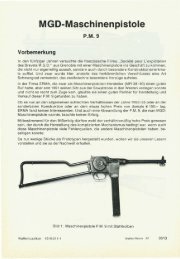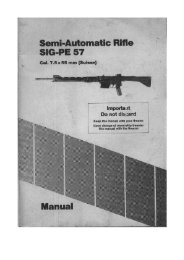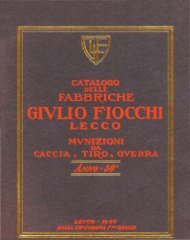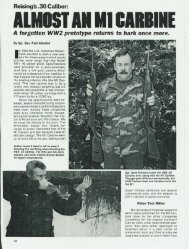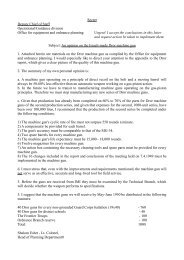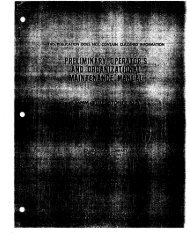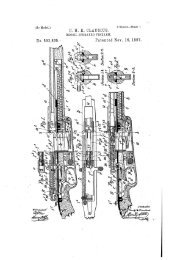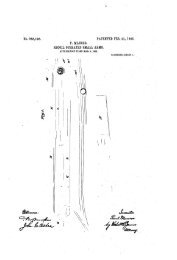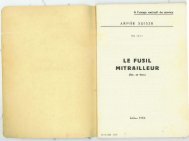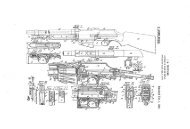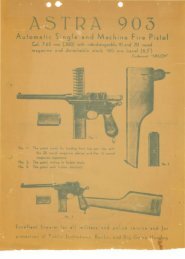The Parabellum Story (GunFacts).pdf - Forgotten Weapons
The Parabellum Story (GunFacts).pdf - Forgotten Weapons
The Parabellum Story (GunFacts).pdf - Forgotten Weapons
You also want an ePaper? Increase the reach of your titles
YUMPU automatically turns print PDFs into web optimized ePapers that Google loves.
This much is left today of the Schweden-bau, where all Mauser handguns were made<br />
from about the turn of the century on. <strong>The</strong> fitting room was at attic level_ with production<br />
departments on the first 3 floors.<br />
Mauser's D-bau survived the postwar dynamite binge. All Luger production will be moved<br />
here by 1971 , and parts will be trucked to the Schramberg-Sulgen facility for assembly<br />
and test firing.<br />
MAUSER'S PARABELLUM SERIAL NUMBER SYSTEMS<br />
All numbers start with a caliber prefix. "I 0" stands for 7 .65, "11" is 9mm, and<br />
"12" will be the centerfire 22 caliber. So far there are three distinct series.<br />
Whether Mauser intends to launch '· new series for forthcoming models such as<br />
the 8" and 16"-barreled guns is not known. <strong>The</strong>y could, or they could just carry<br />
through with the production series as it stands now. Military orders will probably<br />
be numbered in separate series.<br />
SERIES 1- Swiss M1929 pistols rebuilt as Mauser display pieces. Identified by<br />
a double-0 after the caliber prefix, numbered from I 0. Thus, beginning<br />
with the first gun of the series: 10.00.1 0, 10.00.11, and so forth.<br />
Still foggy as to exactly how many were made; probably less than a<br />
dozen and probably no 9mm's.<br />
SERIES 2- Mauser prototypes. 2 finished and 3 more in work. Numbered from<br />
0001. Thus: 10.0001, 10.0002, etc. , and 11.0001 , 11.0002 etc. Pilot<br />
run will probably carry through in this series.<br />
SERIES 3- Production pistols; numbered from 1000. Thus: I 0.1000, 10.1001 ,<br />
10.1002, etc. and 11.1000, 11.1001 , 11.1002, etc.<br />
42 GUNFACTS/ NOVEMBER-OECEMBER-69<br />
border to slope down and meet the<br />
straps. This aesthetic faux pas, says<br />
Mauser, results from their decision to<br />
use pressed checkering with positive<br />
(point upward) diamonds. <strong>The</strong>y have to<br />
have a reasonably flat surface against<br />
which to press, hence the slab shape<br />
with the wide borders. <strong>The</strong>y would<br />
have preferred, they said, to use hand<br />
checkering and run it all the way to<br />
the straps as on the P-08, but costs for<br />
this sort of work were out of reason.<br />
No reactions were forthcoming when I<br />
pointed out that the P-08 stocks had<br />
been machine-checkered, and they could<br />
do it that way.<br />
(Curiously, the stocks on both guns<br />
had been inletted for the long Swiss<br />
7929 grip safety, and then filled in with<br />
plastic wood to match the length of the<br />
new Mauser safety.)<br />
<strong>The</strong> 9mm with its fat, stubby 4"<br />
barrel brought to mind the 1902 Model.<br />
It was a nice looking gun. <strong>The</strong> barrel<br />
was almost untapered, and a tight<br />
radius cut brought it down from Range<br />
diameter. <strong>The</strong> left side of the frame was<br />
stamped "9mm Para od .. 38 Luger,"<br />
reflecting an innocent Germanic faith<br />
in Anglo-Saxon logic. Since we translate<br />
7. 65 to 30 Luger, they figured that being<br />
reasonable folks, we must give the<br />
9 the same treatment. By now they've<br />
discovered we don't, so maybe this<br />
amusing inscription will die aborning.<br />
Meanwhile the noble 9 has briefly acquired<br />
a new name-in Germany.<br />
("od." is short for "oder," which means<br />
"or" in German).<br />
<strong>The</strong> 7.65 sported a 4 3/ 4" tubestrange<br />
since 4 and 6 inches are supposed<br />
to be the forthcoming lengths.<br />
I would have suspected that they had<br />
pirated a pipe from a Swiss pistol, but<br />
this barrel plainly seemed toolroom<br />
built. It came down from Range diameter<br />
in a straight, abrupt taper, which<br />
was thoroughly unsightly, and we hope<br />
that later guns will show a radius here.<br />
(Editorial Note: Late Swiss replacement<br />
barrels do resemble the barrel Stevenson<br />
describes.)<br />
Neither gun had been proof marked,<br />
and the absence of superfluous stamps<br />
was pleasing. <strong>The</strong> polish was nice, and<br />
the bluing was adequately rich. All<br />
told , these were handsome guns, very<br />
close to elegant, and the first of a hundred<br />
thousand or more to come.<br />
<strong>The</strong> Luger is finally back , and like<br />
an old friend we welcome it and forgive<br />
its faults. Or most of them anyway.<br />
ADDITIONAL<br />
COVERAGE<br />
NEXT ISSUE




